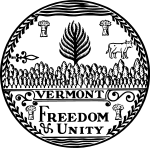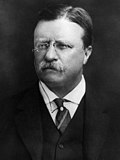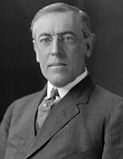| |||||||||||||||||||||||||||||||||
| |||||||||||||||||||||||||||||||||
| |||||||||||||||||||||||||||||||||
| |||||||||||||||||||||||||||||||||
| Elections in Vermont |
|---|
 |
The 1912 United States presidential election in Vermont took place on November 5, 1912, as part of the 1912 United States presidential election which was held throughout all contemporary 48 states. Voters chose four representatives, or electors to the Electoral College, who voted for president and vice president.
Vermont was won by the Republican nominees, incumbent President William Howard Taft from Ohio, and his running mate Vice President James S. Sherman from New York. Taft and Sherman defeated the Progressive Party candidates, former President Theodore Roosevelt from New York and his running mate California Governor Hiram Johnson, and the Democratic nominees, New Jersey Governor Woodrow Wilson and Indiana Governor Thomas R. Marshall.
Taft won the state with a plurality of 37.13%, to Roosevelt's 35.22%, with Wilson in third place at 24.43%. Taft's victory margin over Roosevelt was 1.91%. Historically, Vermont was a bastion of Northeastern Republicanism, and by 1912 it had gone Republican in every presidential election since the founding of the Republican Party. From 1856 to 1908, Vermont had had the longest streak of voting Republican of any state, having never voted Democratic before, and this tradition continued in 1912.
Vermont was one of only two states (along with Utah) to vote for incumbent Republican President William Howard Taft, who was pushed into third place nationally by the strong third-party candidacy of Theodore Roosevelt, a former Republican president who formed his own Bull Moose Party after a failed challenge to Taft for the Republican nod. Taft and Roosevelt split the Republican vote nationally in 1912, with Roosevelt coming in second place behind Wilson nationwide and carrying six states. However, Vermont Republicans proved to be mostly loyal to President Taft as the official Republican nominee, allowing Taft to edge out Roosevelt narrowly to carry the state, leaving Wilson a distant third. Were Taft and Roosevelt voters united behind a single Republican candidate, they would have combined to over 72% of the vote in Vermont.
Socialist candidate Eugene V. Debs, who got 6% of the election vote nationally in 1912, performed much poorer in Vermont with just 1.48% of the vote and finishing in fifth place in Vermont, which was even lower than the 1.74% of the vote won by Prohibition candidate Eugene W. Chafin who finished in fourth in Vermont. However, in the city of Barre, Debs got 24% of the vote, and also got over 12% of the vote within the surrounding town of Barre. Both Barre City and Barre Town are within Washington County, which was Debs' best county in the state by some distance with 5.50%, but which was still below his 6% vote in the election across the nation as a whole. Barre City is the home of the Socialist Labor Party Hall, which was a location for debates among socialists, anarchists and trade union leaders over the future direction of the labor movement in the United States in the early 20th century.
Vermont was the third most Republican state in the nation in 1912, only beaten by Utah and neighboring New Hampshire.[1] However, Taft's margin over Wilson was much greater in Vermont than in Utah or any other state.
- ^ "1912 Presidential Election Statistics". Dave Leip’s Atlas of U.S. Presidential Elections. Retrieved March 5, 2018.





